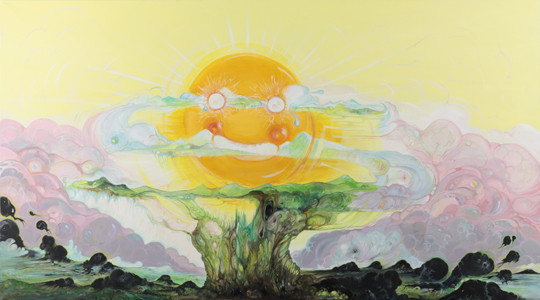Vidya Gastaldon
06 Jun - 16 Sep 2012

© Vidya Gastaldon
Crazy, cruel and full of love, 2011
acrylique et peinture à l’huile
court. Guy Bärtschi, Genève
Crazy, cruel and full of love, 2011
acrylique et peinture à l’huile
court. Guy Bärtschi, Genève
The Eternal Detour cycle, summer sequence 2012
VIDYA GASTALDON
You’re monstrous and I like you
6 June - 16 September 2012
Vidya Gastaldon’s worlds are getting thicker. For some years the artist covered sheets of paper with layer upon layer of coloured pencil, wax crayon, ink, gouache, watercolour and paint of all kinds. Then, just over a year ago, she began using oil on canvas. This change of medium and surface, as well her switch to larger works, has enabled her to adopt an increasingly dense, increasingly material approach. Although this can be taken quite literally — Gastaldon uses a syrupy substance that she dilutes or condenses to suit her requirements — her subject matter, too, is becoming more ‘materialist’.
Over the past decade Vidya Gastaldon has developed what might be termed a neo-Symbolist way of working. Her sculptures and installations made of fabric, her animated films and, above all, her drawings and now also paintings describe a world that is more than just a concrete exterior based solely on rational knowledge. The forms of her landscapes, which are sometimes inhabited by fantastic animals, conjure up a higher or altered consciousness, and invite the viewer to decipher a set of references that lie both within and outside the work. Thus the artist freely makes reference not only to the Bhagavad Gita and the temptations of St Anthony, but also to the Barbapapa family and SpongeBob SquarePants. Borrowed indiscriminately from erudite as well as popular sources, these motifs coexist in perfect harmony — and that is what makes Gastaldon’s work truly ‘psychedelic’. Psychedelic art, which emerged in the early 1960s, was more than just a style — it was a vast popular movement to democratise knowledge, be it sacred (Eastern), scientific (lysergic acid diethylamide) or avant-garde (European Surrealism).
The resulting syncretic, non-dualist outlook tells of a cycle of life — of living matter — that is forever changing, forever transmigrating. But whereas Biolovarama, Gastaldon’s first monographic exhibition at Mamco in 2005, was still largely about the start of a vital process of emergence, the iconographic world in her current exhibition is much closer to Max Ernst’s Europe after the rain, a hallucinatory landscape from 1942 full of an evil the soil will never entirely be able to quench — a phase of indistinctness and annihilation that nevertheless results in a strident joy, as witness the toothy grins and ecstatic gazes of the cups, saucers and other pieces of a paint-daubed tea set, which all seem to be exclaiming You’re monstrous and I like you.
Born in Besançon, France, in 1974, Vidya Gastaldon now lives and works in Geneva and Grange Neuve, France.
* This English translation has been provided with the support of the J.P. Morgan Private Bank.
VIDYA GASTALDON
You’re monstrous and I like you
6 June - 16 September 2012
Vidya Gastaldon’s worlds are getting thicker. For some years the artist covered sheets of paper with layer upon layer of coloured pencil, wax crayon, ink, gouache, watercolour and paint of all kinds. Then, just over a year ago, she began using oil on canvas. This change of medium and surface, as well her switch to larger works, has enabled her to adopt an increasingly dense, increasingly material approach. Although this can be taken quite literally — Gastaldon uses a syrupy substance that she dilutes or condenses to suit her requirements — her subject matter, too, is becoming more ‘materialist’.
Over the past decade Vidya Gastaldon has developed what might be termed a neo-Symbolist way of working. Her sculptures and installations made of fabric, her animated films and, above all, her drawings and now also paintings describe a world that is more than just a concrete exterior based solely on rational knowledge. The forms of her landscapes, which are sometimes inhabited by fantastic animals, conjure up a higher or altered consciousness, and invite the viewer to decipher a set of references that lie both within and outside the work. Thus the artist freely makes reference not only to the Bhagavad Gita and the temptations of St Anthony, but also to the Barbapapa family and SpongeBob SquarePants. Borrowed indiscriminately from erudite as well as popular sources, these motifs coexist in perfect harmony — and that is what makes Gastaldon’s work truly ‘psychedelic’. Psychedelic art, which emerged in the early 1960s, was more than just a style — it was a vast popular movement to democratise knowledge, be it sacred (Eastern), scientific (lysergic acid diethylamide) or avant-garde (European Surrealism).
The resulting syncretic, non-dualist outlook tells of a cycle of life — of living matter — that is forever changing, forever transmigrating. But whereas Biolovarama, Gastaldon’s first monographic exhibition at Mamco in 2005, was still largely about the start of a vital process of emergence, the iconographic world in her current exhibition is much closer to Max Ernst’s Europe after the rain, a hallucinatory landscape from 1942 full of an evil the soil will never entirely be able to quench — a phase of indistinctness and annihilation that nevertheless results in a strident joy, as witness the toothy grins and ecstatic gazes of the cups, saucers and other pieces of a paint-daubed tea set, which all seem to be exclaiming You’re monstrous and I like you.
Born in Besançon, France, in 1974, Vidya Gastaldon now lives and works in Geneva and Grange Neuve, France.
* This English translation has been provided with the support of the J.P. Morgan Private Bank.
